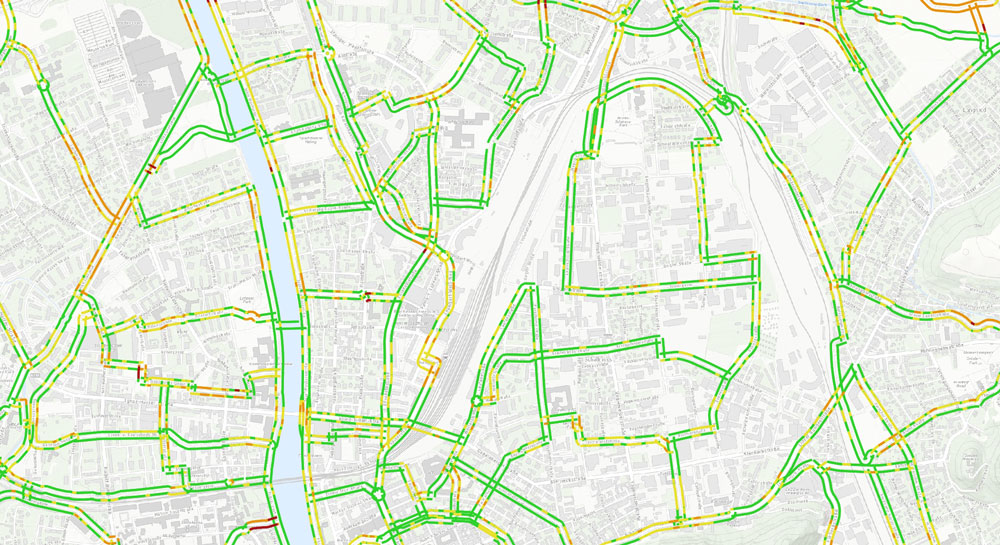
Making Cycling Safer in Constricted Road Conditions
How close and how dangerous are overtaking maneuvers between motor vehicles and cyclists, actually? Under the leadership of Salzburg Research, researchers from Germany, Austria, and Switzerland investigated over 7,000 overtaking maneuvers using state-of-the-art measurement technologies. The results were used to develop concrete recommendations for the safe and comfortable management of cycling traffic.
Road cross sections are often not wide enough to accommodate structurally separated bicycle facilities that meet the guidelines. In the absence of suitable alternative routes, these road sections usually remain gaps in the cycling network. Conflicts that affect road safety accumulate on these sections, in both urban and rural areas.
In a transnational research project led by Salzburg Research, empirical studies and state-of-the-art measurement technologies were used to develop concrete recommendations on how to make cycling on main roads safer and more comfortable under constricted conditions. Using Open Bike Sensors, stationary and mobile laser systems (LiDAR — Light Detection and Ranging) and camera-based analysis, comprehensive data on the traffic situation and its effects on cyclists were collected for the first time. The results show: “A ‘clearer infrastructure language’ and/or restrictive legal measures are needed on roads with narrow conditions in order to guarantee the desired minimum overtaking distance,” says Sven Leitinger, head of the transnational study at Salzburg Research.
Innovative measurement methods for evaluating overtaking processes
A crucial parameter for the safety and comfort of cyclists is the distance that motor vehicles keep when overtaking. In urban areas, an overtaking distance of 1.5 meters is considered safe — this is also the minimum legal overtaking distance in Germany and Austria. Therefore, a special focus of the research project was to objectively determine the actual overtaking distances in numerous field studies.
A variety of data collection and analysis methods were used in the field studies: Open Bike Sensors, stationary and mobile LiDAR sensors, video observations, human sensory measurements, and interviews. In particular, the use of LiDAR sensor technology in the form of a research bicycle was a new and innovative measurement approach that allowed the complete overtaking process to be recorded objectively for the first time.



In total, more than 7,000 overtaking maneuvers by cyclists were analyzed on 22 test routes in Germany, Austria, and Switzerland.
Results of the field studies: Overtaking distances are too small
The extensive field tests clearly showed that conventional cycling infrastructure or mixed motor vehicle and bicycle traffic without cycling infrastructure does not lead to the desired overtaking behavior in constricted spaces. Despite a wide variety of characteristics, the median overtaking distance was between 1.0 and 1.3 meters on almost all test routes, which is below the minimum overtaking distance of 1.5 meters required in Austria and Germany.
During the test rides with the research bicycle, the distances and speeds between the motor vehicle and the bicycle were also recorded at different times — when approaching, reversing, and overtaking. Particularly on the busier test routes, motor vehicles were more likely to tailgate, cyclists were more likely to overtake, and it was more dangerous to reverse in front of cyclists.
Recommended solutions for more safety at bottlenecks
A key solution is to take appropriate measures to ensure that motor vehicles overtake cyclists at a sufficient distance or do not overtake at all.
For road widths between 6.5 and 9.5 meters, the introduction of wide cycle lanes and narrower core lanes at 30 km/h is recommended to optimize overtaking distances. For even narrower sections, the researchers suggest qualified mixed traffic with a maximum speed limit of 30 km/h and additional markings — pictogram chains/sharrows — to increase the visibility of cyclists. In addition, specific recommendations on legal aspects in Germany, Austria, and Switzerland were developed, as well as proposals for asymmetric cycle guidance, for narrow sections, on single lanes, and for participatory processes to involve relevant stakeholders, in order to promote evidence-based decisions on cycle guidance.
The recommendations for action form an important basis for practical implementation in cities and communities in the D-A-CH region. The aim is to close existing gaps in the network, make cycling safer and more attractive, and make transport as a whole more climate-friendly.
Additional materials:
- RADBEST final report: Full report with details of the research work and all recommendations for action (188 pages) + executive summary: RADBEST: Radverkehrsführung bei beengten Straßenverhältnissen.
- Slides from the closing event on 23.01.2025: The slides (including the separate breakout sessions for the 3 countries: Germany, Austria and Switzerland) are available for download here: Abschlussveranstaltung RADBEST – Sichere Radverkehrsführung bei Engstellen: Lösungsansätze für die D-A-CH-Länder
- Press release with images for download: Studie: Den Radverkehr in beengten Straßenverhältnissen sicherer gestalten
Background information on the RADBEST research project
The RADBEST project was carried out by multidisciplinary and multinational consortium: Salzburg Research Forschungsgesellschaft mbH (AT), University of Salzburg, Department of Geoinformatics (AT), Steinbeis Transferzentren GmbH at Karlsruhe University of Applied Sciences, Prof. Eckart, Chair of Transport Ecology (DE), University of Applied Sciences of Eastern Switzerland, Competence Center for Pedestrian and Bicycle Traffic, Prof. Hagedorn (CH), con.sens mobilitätsdesign (AT) and KFV – Kuratorium für Verkehrssicherheit (AT).
RADBEST is an R&D service commissioned by the Austrian Federal Ministry for Climate Protection (BMK), the German Federal Ministry for Digital Affairs and Transport (BMDV) and the Swiss Federal Roads Authority (ASTRA) under the program management of the Austrian Research Promotion Agency (FFG).







